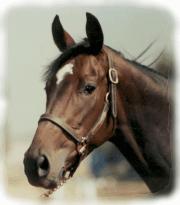A Horse, of Course with Don Blazer |
If you enjoy learning about horses, then you'll love our online courses. Each month you'll find a new column on our web site. We hope you'll enjoy it, and maybe e-mail us with questions or suggestions for other columns. A Horse, Of Course is a monthly column syndicated by Success Is Easy. If you like the column, call your local newspaper, or local horse publication and ask them to subscribe by contacting Success Is Easy. |
Walter, the Indian Pony? Don Blazer copyright©2010 They were painting the barn red and white and it was not hard to see what Walter, a horse, of course, had done. "Have you been bothering the painters, Walter?" I asked. "Nope," Walter said. "Then how did that white circle of paint get around your eye? And how come you've got a red paintbrush imprint on your shoulder? And why all the other markings of paint?" "I'm Cheyenne," Walter said, turning his hindquarters toward me. In his tail he had a pigeon feather. "I wear the feather of the eagle," he said. "Indian war pony," he attempted to convince me. "You are not a Cheyenne war pony," I said, hopefully closing the matter. "Cherokee?" he asked. No, you're not Cherokee, I said as a preface to my explanation. The American Indian's warhorse was most probably a descendant of the Barb horses introduced into Spain by the invading Moors of the 8th Century. Once in American and in the hands of the Indians they developed a personality of their own. In addition, without grains, but always a constant regimen of work, they soon became a distinct breed-tough and rugged with plenty of endurance and speed. He wasn't a very pretty horse, averaging about 14 hands and 700 pounds. He had a large head and a large barrel, heavy shoulders and hips, strong legs and small feet. "I must be Apache," Walter said. "I don't think so," I replied. "But you were trained in somewhat the Indian fashion. "How's that?" Walter asked. Until the horse fell into the American Indian's hands, all horses were trained on the world-wide theory of the time-domination; bigger spurs, nastier bits, bigger whips, greater restraints where the tools of the day. The Indian reversed the theory and tried something totally new-training the horse with kindness. The Indian had to approach the horse without frightening him. He slowly let the horse become familiar with him and with his bow, arrows, leather thong bit and blanket. When it came time to mount the horse, the Indian would gently put his elbow on the horse's back and apply pressure for short periods of time. It may have taken weeks before the horse would let the rider mount, but that was okay with the Indian. Many horses were taken into a river or lake until the water reached their shoulders-then the rider mounted. The horse might try to buck or jump, but the water kept him injury free, and after having his head under water a time or two, he quieted down nicely. "I'm probably a Blackfoot," Walter said, looking at his hooves. "Can't be," I pointed out. "Both of your hind feet are white." I told Walter the American Indian got his horses sometime after 1650. And he didn't just find them wandering about, lost, I explained. He stole them. (Horses are herd animals; they don't just wander off by themselves.) Spanish records dated 1659 report Apache raiders carried off 300 head of livestock including horses. Horses and Indians seemed to possess a certain affinity for each other, I told Walter. The Indian didn't feed treats, or grain, or curry and groom and shampoo his horse….but he didn't confine him either. He worked his horse, but he also gave him freedom to graze and play and be a horse. "I know, I know," said Walter. "I'm Pawnee!" "You're going to be the Pawnee, alright," I said. "And I'm going to be the pawn-0R!" Visit A Horse, Of Course on the Internet at www.donblazer.com |
